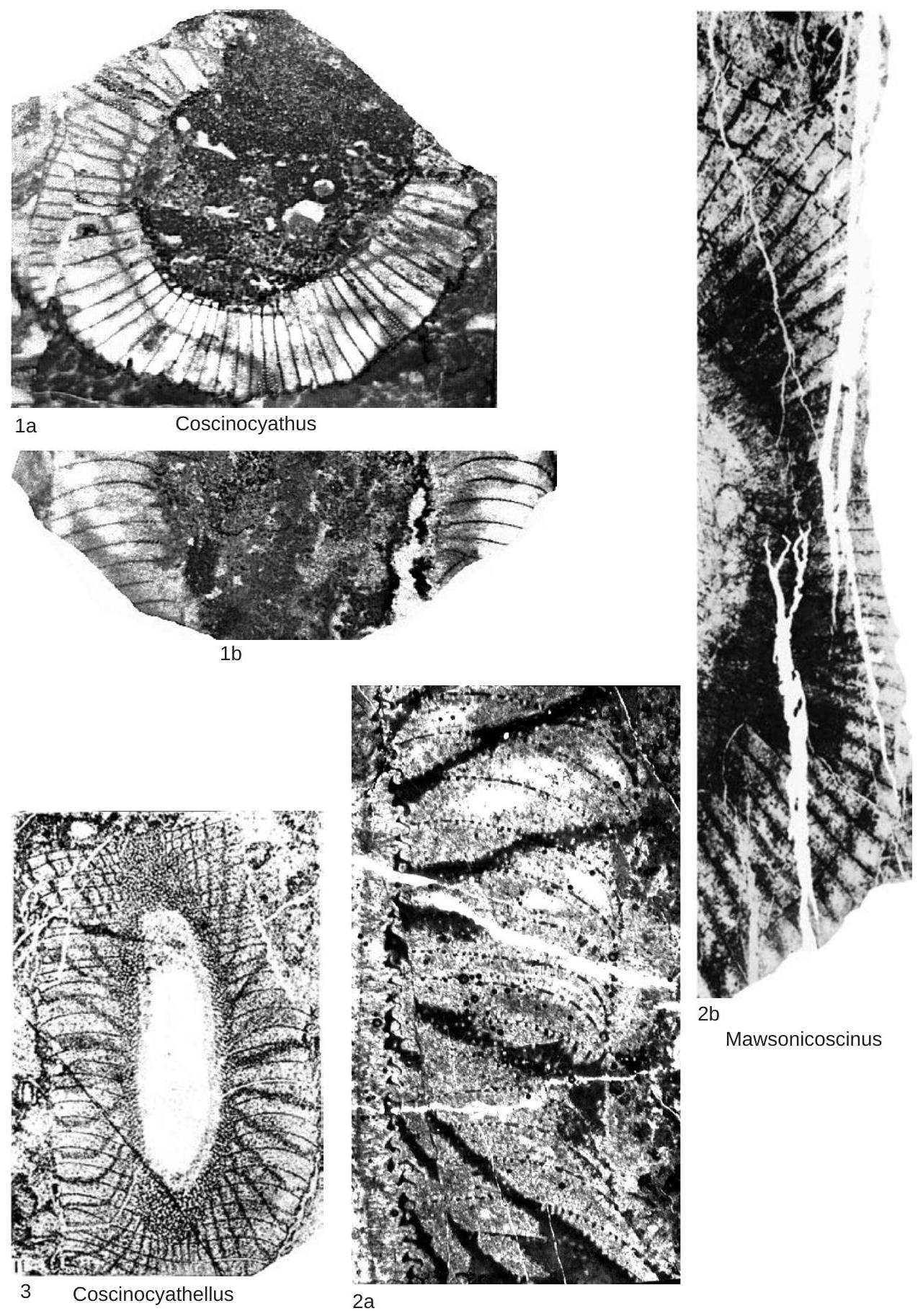Welcome to the Treatise on Invertebrate Paleontology!
Please enter a genera name to retrieve more information.

Coscinocyathus
Classification
Phylum:
Porifera
Class:
Archaeocyatha
Order:
Capsulocyathida
Suborder:
Coscinocyathina
Superfamily:
Coscinocyathoidea
Family:
Coscinocyathidae
Formal Genus Name and Reference:
Coscinocyathus BORNEMANN, 1884, p. 704
Type Species:
C. dianthus, SD by exercise of ICZN plenary powers by Melville, 1974, p. 155, following application by Debrenne, 1970b, p. 207, negating SD of C. tuba Bornemann, 1884, p. 704 by Ting, 1937, p. 360 (now type of Tubicoscinus Debrenne in Debrenne, Zhuravlev, & Rozanov, 1989, p. 137), lectotype, Bornemann, 1886, pl. 17, 2-7, Debrenne, 1964, pl. 21, 1-2, SD DEBRENNE, 1964, p. 169, GML An597, Halle
Images
(Click to enlarge in a new window)
Fig. 608, 1a-b. *C. dianthus, Matoppa Formation, Botoman, Canal Grande, Sardinia, Italy, lectotype, GML An597, a, transverse section, X4, b, longitudinal section, X4 (Bornemann, 1886).
Synonyms
Geographic Distribution
Siberian Platform, Altay Sayan, Tuva, Mongolia, Transbaikalia, Far East, Tajikistan, Morocco, Iberia, Sardinia
Age Range
Beginning Stage in Treatise Usage:
lower Cambrian (Atdabanian 2)
Beginning International Stage:
Cambrian Stage 3
Fraction Up In Beginning Stage:
18
Beginning Date:
519.83
Ending Stage in Treatise Usage:
lower Cambrian (Botomian 3)
Ending International Stage:
Cambrian Stage 4
Fraction Up In Ending Stage:
25
Ending Date:
513.13
Description
Inner wall with several rows of simple pores per intersept, septa completely porous, tabulae with normal pores
References
Bornemann, J. G. 1884. Bericht über die Fortsetzung seiner Untersuchungen cambrischer Archaeocyathus: Formen und verwandter Organismen von der Insel Sardinien. Deutsche Geologische Gesellschaft, Zeitschrift 36:702-706.
Museum or Author Information
Classification
Phylum:
Porifera
Class:
Archaeocyatha
Order:
Capsulocyathida
Suborder:
Coscinocyathina
Superfamily:
Coscinocyathoidea
Family:
Coscinocyathidae
Formal Genus Name and Reference:
Coscinocyathus BORNEMANN, 1884, p. 704
Type Species:
C. dianthus, SD by exercise of ICZN plenary powers by Melville, 1974, p. 155, following application by Debrenne, 1970b, p. 207, negating SD of C. tuba Bornemann, 1884, p. 704 by Ting, 1937, p. 360 (now type of Tubicoscinus Debrenne in Debrenne, Zhuravlev, & Rozanov, 1989, p. 137), lectotype, Bornemann, 1886, pl. 17, 2-7, Debrenne, 1964, pl. 21, 1-2, SD DEBRENNE, 1964, p. 169, GML An597, Halle
Images
(Click to enlarge in a new window)
Fig. 608, 1a-b. *C. dianthus, Matoppa Formation, Botoman, Canal Grande, Sardinia, Italy, lectotype, GML An597, a, transverse section, X4, b, longitudinal section, X4 (Bornemann, 1886).
Synonyms
Geographic Distribution
Siberian Platform, Altay Sayan, Tuva, Mongolia, Transbaikalia, Far East, Tajikistan, Morocco, Iberia, Sardinia
Age Range
Beginning Stage in Treatise Usage:
lower Cambrian (Atdabanian 2)
Beginning International Stage:
Cambrian Stage 3
Fraction Up In Beginning Stage:
18
Beginning Date:
519.83
Ending Stage in Treatise Usage:
lower Cambrian (Botomian 3)
Ending International Stage:
Cambrian Stage 4
Fraction Up In Ending Stage:
25
Ending Date:
513.13
Description
Inner wall with several rows of simple pores per intersept, septa completely porous, tabulae with normal pores
References
Bornemann, J. G. 1884. Bericht über die Fortsetzung seiner Untersuchungen cambrischer Archaeocyathus: Formen und verwandter Organismen von der Insel Sardinien. Deutsche Geologische Gesellschaft, Zeitschrift 36:702-706.
